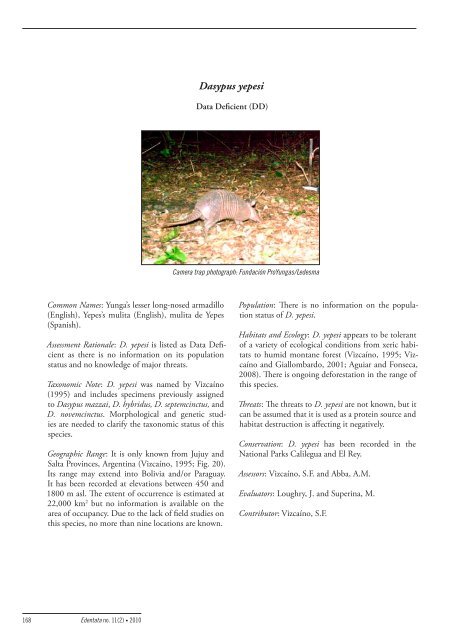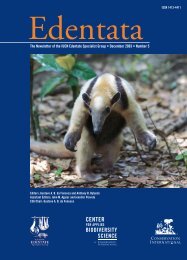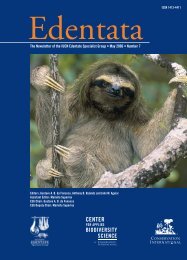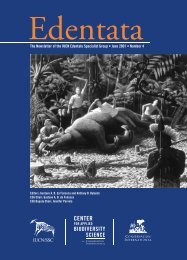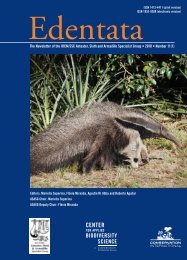Edentata 11(2), 2010 - Anteater, Sloth & Armadillo Specialist Group
Edentata 11(2), 2010 - Anteater, Sloth & Armadillo Specialist Group
Edentata 11(2), 2010 - Anteater, Sloth & Armadillo Specialist Group
- No tags were found...
You also want an ePaper? Increase the reach of your titles
YUMPU automatically turns print PDFs into web optimized ePapers that Google loves.
Dasypus yepesiData Deficient (DD)Camera trap photograph: Fundación ProYungas/LedesmaCommon Names: Yunga’s lesser long-nosed armadillo(English), Yepes’s mulita (English), mulita de Yepes(Spanish).Assessment Rationale: D. yepesi is listed as Data Deficientas there is no information on its populationstatus and no knowledge of major threats.Taxonomic Note: D. yepesi was named by Vizcaíno(1995) and includes specimens previously assignedto Dasypus mazzai, D. hybridus, D. septemcinctus, andD. novemcinctus. Morphological and genetic studiesare needed to clarify the taxonomic status of thisspecies.Geographic Range: It is only known from Jujuy andSalta Provinces, Argentina (Vizcaíno, 1995; Fig. 20).Its range may extend into Bolivia and/or Paraguay.It has been recorded at elevations between 450 and1800 m asl. The extent of occurrence is estimated at22,000 km 2 but no information is available on thearea of occupancy. Due to the lack of field studies onthis species, no more than nine locations are known.Population: There is no information on the populationstatus of D. yepesi.Habitats and Ecology: D. yepesi appears to be tolerantof a variety of ecological conditions from xeric habitatsto humid montane forest (Vizcaíno, 1995; Vizcaínoand Giallombardo, 2001; Aguiar and Fonseca,2008). There is ongoing deforestation in the range ofthis species.Threats: The threats to D. yepesi are not known, but itcan be assumed that it is used as a protein source andhabitat destruction is affecting it negatively.Conservation: D. yepesi has been recorded in theNational Parks Calilegua and El Rey.Assessors: Vizcaíno, S.F. and Abba, A.M.Evaluators: Loughry, J. and Superina, M.Contributor: Vizcaíno, S.F.168<strong>Edentata</strong> no. <strong>11</strong>(2) • <strong>2010</strong>


